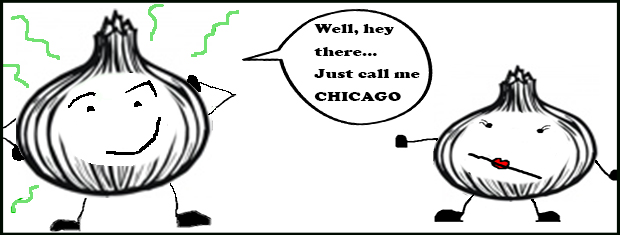Sniffing for Chicago’s wild onion
By Chelsi Moy

Sniffing for Chicago’s wild onion
By Chelsi MoyWhat’s wild, smelly and leaves a bad taste in your mouth? Chicago.
Now, before you go grabbing for the pitchforks and torches, know that it’s a joke … about wild onions, that is.
Yes, Chicago is named after a wild, smelly onion, one that — more than three centuries ago — grew in abundance at the mouth of the Chicago River. There were so many that when the first French settlers asked the local Indians what the area was called, they said, “Chicagoua,” a word for the wild bulb plant, according to Bruce Kraig, president of the Culinary Historians of Chicago.
Now, cement sidewalks and paved roads cover up the marshlands that once served as home to these onions.
Like many area residents, Doug Morris of Hinsdale had heard this story before. What he didn’t know, though, was whether this was actual history, and he certainly didn’t have any idea of what happened since then. So he asked Curious City:
Does the wild onion for which Chicago got its name still grow in the region? And does it smell bad?
We decided that the only way to get to the bottom of this story was to actually find the wild onion for which Chicago is named. Speculation and hearsay were unacceptable. We needed to see the bulb with our own eyes.
The search
Morris, his daughter Libby and I met Doug Taron, curator of biology at the Peggy Notebaert Nature Museum, at the Somme Prairie Nature Preserve in the center of Northbrook to look for wild onions.

The thing we knew beforehand (and you should know now) is that onion are part of the allium family. There are many types of alliums, but through a process of elimination, historians and scientists can point to three kinds that grow in the region and which Chicago might be named. Narrowing it down further, however, poses a challenge.
The three kinds of onions in question include the nodding onion, the wild garlic and the wild leek. The latter is often referred to as the ramp. While it’s debatable which onion is named after Chicago, many sources I spoke with for this story say it’s the ramp.
During our excursion in the forest preserve, we were lucky enough to find all three species. The nodding onion was in bloom with it’s pinkish-purple flowers beginning to open. The field garlic blooms in the spring and forms tiny bulblets on the tip of the blooming stalk.
The wild leek is also harvested in the spring.

The smell factor
About that aroma. Is it fair to call the ramp stinky? Well, that’s debatable.
“It smells like green garlic,” Kraig said. “It smells pleasantly oniony or garlicky, but it’s not overpowering. It smells like a green garlic field.”
Despite the smell, ramps are a delicacy in many restaurants in and around Chicago. In fact, over the past five years the local green has become a culinary trend. Chefs such as John DuBois at Green Zebra — a contemporary vegetarian restaurant — look forward to their arrival each spring. It’s one of the first “greens” that become available for harvest following the cold winter, he said. He describes it as having a part-garlic, part-oniony taste.
One way DuBois likes to use ramps is in making pesto. However, the chef and scientists I talked with say that ramps are tasty simply grilled on the BBQ.

Where can you find ramps?
Green Zebra turns to urban forager Dave Odd, who says he harvests ramps sustainably from a private lot about 60 miles outside of Chicago.
It’s important to note that while the forest preserves in Chicagoland are good places to locate ramps, you’re not allowed to pick them — just as you’re not allowed to pick anything there, in fact.
In the spring you can find ramps at some artisan or high-end grocery stores such as Whole Foods. Otherwise, Odd recommends you ask private property owners with land adjacent to forest preserves for permission to harvest. He says as far as harvesting goes, private property seems to be the only way to pick wild ramps consistently in the region.
However, Bill Burger, a curator emeritus of botany at the Field Museum, offers another suggestion: Don’t pick at all.
“The last thing we need to do is ask a couple million people to go out in the woods and add to their culinary delight,” he said. “Obviously if you pull them up to make a salad out of them then there won’t be any flowers or fruits later on and that’s a good way to send things bye-bye.”

Chelsi Moy is a WBEZ intern for Curious City. Follow her @chelsimoy.



